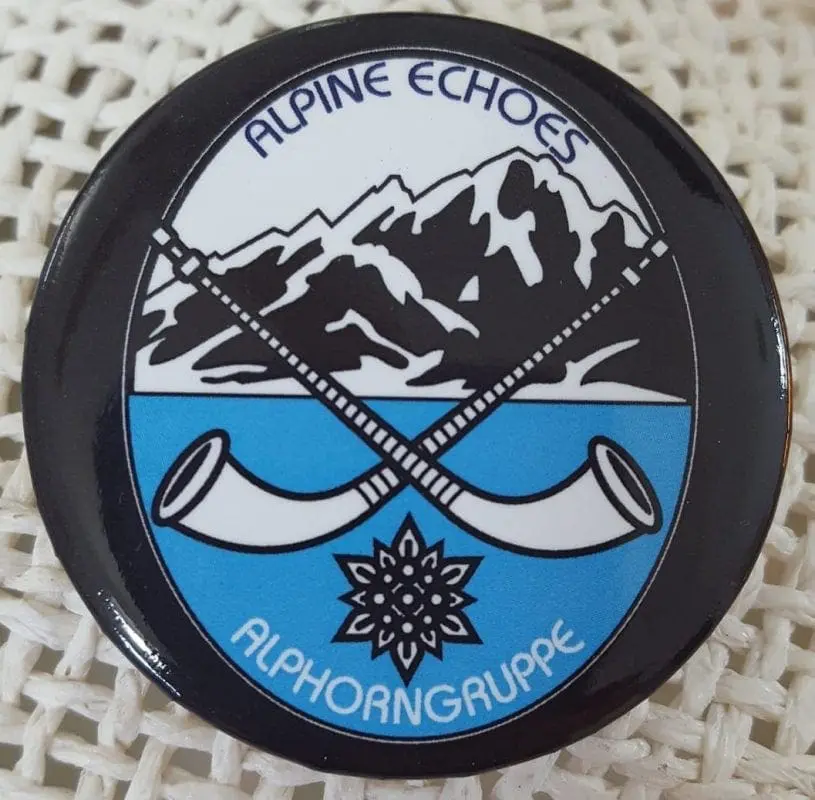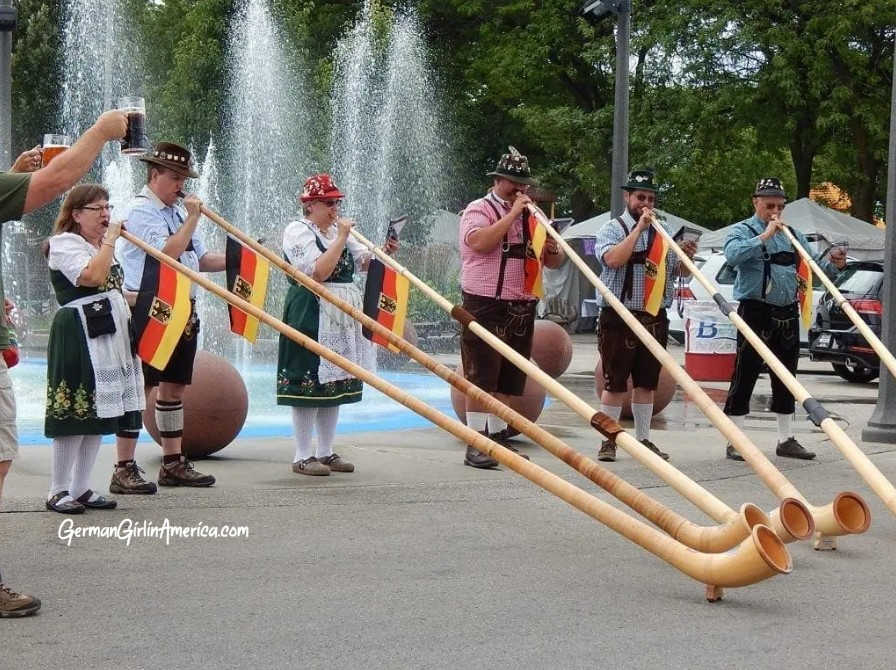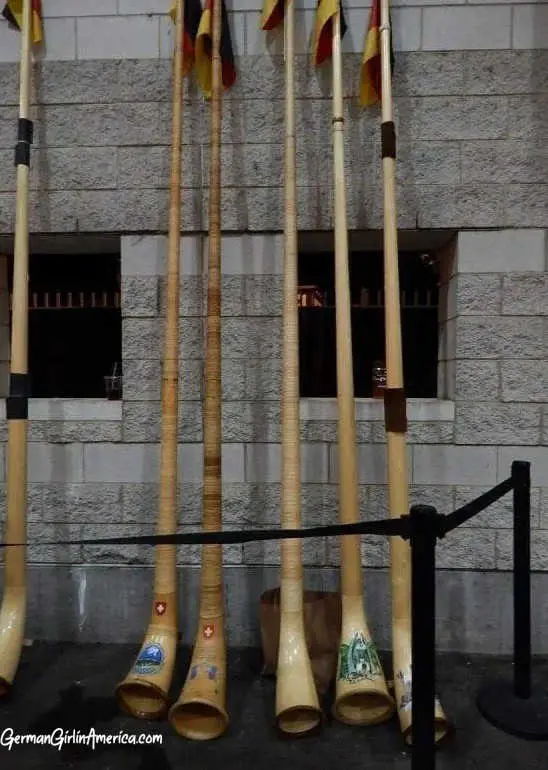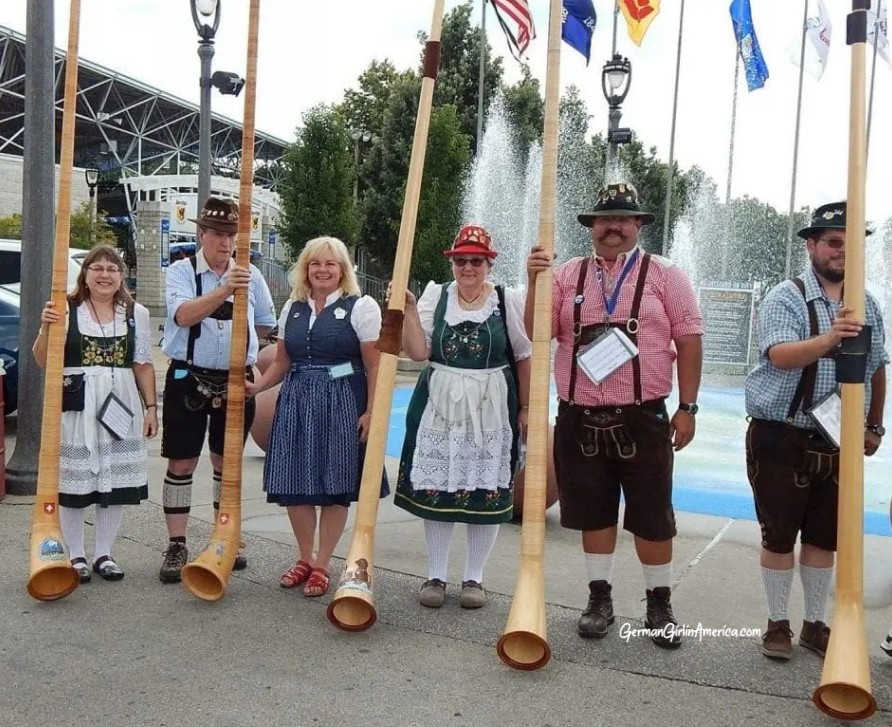A massive crowd gathered near the Welcome Gates of German Fest in Milwaukee to see The Alpine Echoes perform. It’s not every day you see a half dozen Alpenhorn players playing real music! I’m sure it was the first time many people even heard the Alp Horn outside of a Ricola Ad! (You can hear it in your mind now, can’t you? RIIII Cola!) The Alpine Echos were everywhere over the weekend- at the gates, in the parade, and playing in the opening ceremony with the Freistadt Alte Kameraden Band. And everywhere they went, those long horns drew a crowd. Luckily, I got a chance to talk to them one evening and found out there is much more to the Alp Horn than cough drops.
The Alpine Echos performing at the entrance of German Fest Milwaukee
Who are the Alpine Echos? And why do they play Alpenhorns??
Interesting and fun facts I learned while talking to Robert Sturgeon and his wife Kris. 1. Alpenhorns in the Key of F Sharp are 11 feet 3 inches long. 2. You can occasionally buy an Alpenhorn one.
(Although my UPS guy would not be tremendously impressed with me if he had to deliver that package. And the neighbors would be even less impressed with me if I tried to PLAY an Alp Horn in the yard.)
Robert and Kris weren’t always Alpenhorn players. Both are members of the German Band Inc., where they play other (much shorter) instruments. Robert became interested in the Alphorn after a trip to Switzerland, where he was able to purchase an Alphorn from Pilatus-Aplhorn, made by the renowned Joseph Stocker. Since Herr Stocker was retired and not in the mood to deal with tourists, this was quite a feat involving several trips up and down the mountain! Today, both Sturgeons play Stocker horns. His is an antique made in 1960, and hers is a newer model made in 2016. More recently, they purchased 6 Alphorns and encouraged the Brass members of the German Band Inc. to form the Alpine Echos. And when you hear them all play together, it’s magical! And watching them all walk together with their horns is intimidating!
Follow The German Band, Inc to find out where they will be playing Alpenhorn next!
Kris took the time to explain how to make music with these LONG horns. Like a Brass Instrument, but made of wood. There are no buttons or valves, like a trumpet, and no slide, like a trombone. All of the different tones are made by blowing into the horn. And a lot has to do with lip pressure. She showed me the mouthpiece, which is separate from the horn and looks like a wooden schnapps glass with a stem. There are three different lengths of Alphorn, and each makes a different pitch. F sharp is 11 feet, 3 inches long, the Alphorn with a fundamental pitch of F is 12 feet, 3 inches long, and the Alpenhorn with a fundamental pitch of G is 13 feet, 2 inches long. And each horn has a 4-octave range. Their mellow reverberating sound is a result of their conical shape.

How are Alphorns Made
Originally, artisans carved the Alphorn from young, crooked pines that grew high in the Alps. These trees would grow out from steep mountains and then turn up toward the sun. Because the trees in the Alps grew so slowly, the rings were close together, and the pine was sturdy and strong. The young trees would be cut down and hollowed out in sections that were then put back together. The VERY EARLY Alphorns were cut lengthwise in half, hollowed out, then strapped back together with strips of leather. Today’s Alphorns are made from Ash, Birch, or even CARBON FIBER! They are cut into 3 or 4 sections, hollowed out, and then joined. It’s much easier to disassemble the new horns for transport, making it easier if you want to drive somewhere with your Alphorn.
The LONG tube tapers toward the mouthpiece, and the bottom end is an upturned bell. It looks like a long Cowhorn. At the bottom, you also find little “feet” that the horn can rest on. Many Alphorns have decorations painted on them.
Alpenhorns on a break
More Alpenhorn History
In Switzerland and the German Alps, the cows graze on the sweetest grass high in Alpine Meadows. The best way for shepherds to communicate with their family down in the Valleys was with an Alphorn. Different signals were established to let everyone know that things were all right up on the mountain. But the Alphorn was more than just an unwieldy telephone; it was also used to soothe the cattle during milking and to encourage them to get up the last stretch of mountain road. In some Catholic Cantons in central Switzerland, an Alpenhorn calls parishioners to evening prayers.
In the last 200 years, the use of the Alphorn by cowherds fell off. Luckily, in 1820, the instrument was saved from obscurity by Niklaus von Mülinen from Bern, who restored old Alphorns and passed them along to musicians. He also held Summer Music Classes to teach people to play the Alphorn. But they didn’t just play music to soothe cows! Folk songs with yodeling and Alpenhorn were written, and classical composers Johann Brahms and Leopold Mozart wrote symphonies incorporating the Alphorn.
The long horns became fixtures at traditional festivals and eventually became a symbol of Switzerland.
Looking for Alphorn Music
Alpine Echos Generosity
Both Robert and Kris, as well as the other members of the Alpine Echos, are wildly enthusiastic about the Alpenhorn and making music with them. The whole band acts as musical ambassadors who share their love of traditional German and Swiss music (and if you aren’t careful, you might find yourself buying a horn and joining in!). But most impressive is their generosity. Both the German Band, Inc. and the Alpine Echos donate ALL of the money they earn performing to the Food Pantry in Oberlin, Indiana, as well as the Hobart Food Pantry in Hobart, Indiana. That is a lot of driving, a lot of toting an 11-pound instrument, and a lot of playing. And it all goes to charity.
Thanks to the Alpine Echos, and especially to Robert and Kris for teaching me so much about the iconic Alpenhorn!






